Assessment of Serpentine Group Minerals in Soils: A Case Study from the Village of San Severino Lucano (Basilicata, Southern Italy)
Abstract
:1. Introduction
2. Geological Setting
3. Materials and Methods
4. Results
4.1. TEM Characterization
4.2. Thermal Analysis Characterization
5. Discussion and Conclusions
Author Contributions
Funding
Acknowledgments
Conflicts of Interest
References
- World Health Organization (WHO). Asbestos and Other Natural Mineral Fibers. Environmental Health Criteria, 53; World Health Organization: Geneva, Switzerland, 1986; p. 194. [Google Scholar]
- National Institute for Occupational Safety and Health (NIOSH). Asbestos and Other Elongated Mineral Particles: State of the Science and Roadmap for Research; Current Intelligence Bulletin, June 2008-Revised Draft; National Institute for Occupational Safety and Health (NIOSH): Washington, DC, USA, 2008.
- Punturo, R.; Cirrincione, R.; Pappalardo, G.; Mineo, S.; Fazio, E.; Bloise, A. Preliminary laboratory characterization of serpentinite rocks from Calabria (southern Italy) employed as stone material. J. Mediterr. Earth Sci. 2018, 10, 79–87. [Google Scholar]
- International Agency for Research on Cancer (IARC). Asbestos (Chrysotile, Amosite, Crocidolite, Tremolite, Actinolite, and Anthophyllite) IARC Monographs. Arsenic, Metals, Fibers and Dusts; International Agency for Research on Cancer: Lyon, France, 2009; pp. 147–167. [Google Scholar]
- Harper, M. 10th Anniversary critical review: naturally occurring asbestos. J. Environ. Monit. 2008, 10, 1394–1408. [Google Scholar] [CrossRef] [PubMed]
- Compagnoni, R.; Ferraris, G.; Fiora, L. Balangeorite, a new fibrous silicate related to gageite from Balangero, Italy. Am. Mineral. 1983, 68, 214–219. [Google Scholar]
- Ballirano, P.; Pacella, A.; Bloise, A.; Giordani, M.; Mattioli, M. Thermal Stability of Woolly Erionite-K and Considerations about the Heat-Induced Behaviour of the Erionite Group. Minerals 2018, 8, 28. [Google Scholar] [CrossRef]
- Gianfagna, A.; Ballirano, P.; Bellatreccia, F.; Bruni, B.; Paoletti, E.; Oberti, R. Characterization of amphibole fibers linked to mesothelioma in the area of Biancavilla, eastern Sicily, Italy. Mineralog. Mag. 2003, 67, 1221–1229. [Google Scholar] [CrossRef]
- Cardile, V.; Lombardo, L.; Belluso, E.; Panico, A.; Capella, S.; Balazy, M. Toxicity and Carcinogenicity Mechanisms of Fibrous Antigorite. Int. J. Environ. Res. Public Health 2007, 4, 1–9. [Google Scholar] [CrossRef] [PubMed] [Green Version]
- Gualtieri, A.F. Mineral Fibers: Crystalchemistry, Chemical-Physicalproperties, Biological Interaction and Toxicity; European Mineralogical Union and Mineralogical Society of Great Britain and Ireland: London, UK, 2017; p. 533. [Google Scholar]
- Pugnaloni, A.; Giantomassi, F.; Lucarini, G.; Capella, S.; Bloise, A.; Di Primio, R.; Belluso, E. Cytotoxicityinduced by exposure to natural and synthetic tremolite asbestos: An in vitro pilot study. Acta Histochem. 2013, 115, 100–112. [Google Scholar] [CrossRef] [PubMed]
- Bloise, A.; Catalano, M.; Barrese, E.; Gualtieri, A.F.; Gandolfi, N.B.; Capella, S.; Belluso, E. TG/DSC study of the thermal behaviour of hazardous mineral fibers. J. Therm. Anal. Calorim. 2016, 123, 2225–2239. [Google Scholar] [CrossRef]
- Bloise, A.; Punturo, R.; Catalano, M.; Miriello, D.; Cirrincione, R. Naturally occurring asbestos (NOA) in rock and soil and relation with human activities: The monitoring example of selected sites in Calabria (southern Italy). Ital. J. Geosci. 2016, 135, 268–279. [Google Scholar] [CrossRef]
- Censi, P.; Zuddas, P.; Randazzo, L.A.; Tamburo, E.; Speziale, S.; Cuttitta, A.; Punturo, R.; Santagata, R. Source and nature of inhaled atmospheric dust from trace element analyses of human bronchial fluids. Environ. Sci. Technol. 2011, 45, 6262–6267. [Google Scholar] [CrossRef] [PubMed]
- Censi, P.; Tamburo, E.; Speziale, S.; Zuddas, P.; Randazzo, L.A.; Punturo, R.; Aricò, P. Yttrium and lanthanides in human lung fluids, probing the exposure to atmospheric fallout. J. Hazard. Mater. 2011, 186, 1103–1110. [Google Scholar] [CrossRef] [PubMed]
- Bloise, A.; Barca, D.; Gualtieri, A.F.; Pollastri, S.; Belluso, E. Trace elements in hazardous mineral fibres. Environ. Pollut. 2016, 216, 314–323. [Google Scholar] [CrossRef] [PubMed]
- Punturo, R.; Bloise, A.; Critelli, T.; Catalano, M.; Fazio, E.; Apollaro, C. Environmental implications related to natural asbestos occurrences in the ophiolites of the Gimigliano-Mount Reventino Unit (Calabria, southern Italy). Int. J. Environ. Res. 2015, 9, 405–418. [Google Scholar]
- Acosta, A.; Pereira, M.D.; Shaw, D.M.; Bea, F. Serpentinización de la peridotita de Ronda (cordillera Betica) comorespuesta a la interacción con fluidosricos en volátiles: comportamiento del boro. Rev. Soc. Geol. Esp. 1997, 10, 99–106. [Google Scholar]
- Burragato, F.; Comba, P.; Baiocchi, V.; Palladino, D.M.; Simei, S.; Gianfagna, A.; Pasetto, R. Geo-volcanological, mineralogical and environmental aspects of quarry materials related to pleural neoplasm in the area of Biancavilla, Mount Etna (Eastern Sicily, Italy). Environ. Geol. 2005, 47, 855–868. [Google Scholar] [CrossRef]
- Constantopoulos, S.H. Environmental mesothelioma associated with tremolite asbestos: Lessons from the experiences of Turkey, Greece, Corsica, New Caledonia and Cyprus. Regul. Toxicol. Pharmacol. 2008, 52, 110–115. [Google Scholar] [CrossRef] [PubMed]
- Pereira, M.D.; Peinado, M.; Blanco, J.A.; Yenes, M. Geochemical characterization of serpentinites at cabo ortegal, northwestern Spain. Can. Mineral. 2008, 46, 317–327. [Google Scholar] [CrossRef]
- Bloise, A.; Belluso, E.; Critelli, T.; Catalano, M.; Apollaro, C.; Miriello, D.; Barrese, E. Amphibole asbestos and other fibrous minerals in the meta-basalt of the Gimigliano-Mount Reventino Unit (Calabria, south-Italy). Rend Online Soc Geol It. 2012, 21, 847–848. [Google Scholar]
- Navarro, R.; Pereira, D.; Gimeno, A.; Barrio, S.D. Verde Macael: A Serpentinite Wrongly Referred to as a Marble. Geosciences 2013, 3, 102–113. [Google Scholar] [CrossRef] [Green Version]
- Gaggero, L.; Sanguineti, E.; Yus González, A.; Militello, G.M.; Scuderi, A.; Parisi, G. Airborne asbestos fibers monitoring in tunnel excavation. J. Environ. Manag. 2017, 196, 583–593. [Google Scholar] [CrossRef] [PubMed]
- Worliczek, E. Naturally occurring asbestos: The perception of rocks in the mountains of New Caledonia. In Environmental Transformations and Cultural Responses: Ontologies, Discourses, and Practices in Oceania; Dürr, E., Pascht, A., Eds.; Springer: Berlin, Germany, 2017; pp. 187–214. [Google Scholar]
- Bloise, A.; Catalano, M.; Critelli, T.; Apollaro, C.; Miriello, D. Naturally occurring asbestos: Potential for human exposure, San Severino Lucano (Basilicata, Southern Italy). Environ. Earth Sci. 2017, 76, 648. [Google Scholar] [CrossRef]
- Bernardini, P.; Schettino, B.; Sperduto, B.; Giannadrea, F.; Burragato, F.; Castellino, N. Tre Casi di mesotelioma pleurico ed inquinamento ambientale da rocce affioranti di tremolite in Lucania. GIMLE 2003, 25, 408–411. [Google Scholar]
- Burragato, F.; Mastacchi, R.; Papacchini, L.; Rossini, F.; Sperduto, B. Mapping of risks due to particulates of natural origin containing fibrous tremolite: The case of Seluci di Lauria (Basilicata, Italy). In Proceedings of the 1st General Assembly, Nice, France, 25–30 April 2004. [Google Scholar]
- Pasetto, R.; Bruni, B.; Bruno, C.; Cauzillo, G.; Cavone, D.; Convertini, L.; De Mei, B.; Marconi, A.; Montagano, G.; Musti, M.; et al. Mesotelioma pleurico ed esposizione ambientale a fibre minerali: Il caso di un’area rurale in Basilicata. Ann. Ist. Super. Sanita. 2004, 40, 251–265. [Google Scholar] [PubMed]
- Punturo, R.; Ricchiuti, C.; Mengel, K.; Apollaro, C.; De Rosa, R.; Bloise, A. Serpentinite-derived soils in southern Italy: Potential for hazardous exposure. J. Mediterr. Earth Sci. 2018, 10, 51–61. [Google Scholar]
- Monaco, C.; Tortorici, L. Tettonica estensionale quaternaria nell’Arco Calabro e in Sicilia orientale. Studi Geologici Camerti 1995, 2, 351–362. [Google Scholar]
- Monaco, C.; Tortorici, L.; Paltrinieri, W. Structural evolution of the Lucanian Apennines, southern Italy. J. Struct. Geol. 1998, 20, 617–638. [Google Scholar] [CrossRef]
- Vezzani, L. La Formazione del Frido (Neocomiano- Aptiano) tra il Pollino e il Sinni. Geol. Rom. 1969, 8, 129–176. [Google Scholar]
- Amodio Morelli, L.; Bonardi, G.; Colonna, V.; Dietrich, D.; Giunta, G.; Ippolito, F.; Liguori, V.; Lorenzoni, S.; Paglioncino, A.; Perrone, V. L’ arco Calabro Peloritano nell’ orogene Appenninico-Maghrebide. Mem. Soc. Geol. It. 1976, 17, 1–60. [Google Scholar]
- Vezzani, L. La sezione tortoniana di Perosa sul fiume Sinni presso Episcopia (Potenza). Geol. Rom. 1966, 5, 263–290. [Google Scholar]
- Sansone, M.T.C.; Rizzo, G.; Mongelli, G. Petrochemical characterization of mafic rocks from the Ligurian ophiolites, Southern Apennines. Int. Geol. Rev. 2011, 53, 130–156. [Google Scholar] [CrossRef]
- Rizzo, G.; Cristi Sansone, M.T.; Perri, F.; Laurita, S. Mineralogy and petrology of the metasedimentary rocks from the frido unit (southern apennines, Italy). Period. Mineral. 2016, 85, 153–168. [Google Scholar]
- Sansone, M.T.C.; Prosser, G.; Rizzo, G.; Tartarotti, P. Spinel-peridotites of the frido unit ophiolites (southern apennine-italy): Evidence for oceanic evolution. Period. Mineral. 2012, 81, 35–59. [Google Scholar]
- Whitney, D.L.; Evans, B.W. Abbreviations for names of rock-forming minerals. Am. Mineral. 2010, 95, 185–187. [Google Scholar] [CrossRef]
- Leake, B.E.; Woolley, A.R.; Arps, C.E.S.; Birch, W.D.; Gilbert, M.C.; Grice, J.D.; Hawthorne, F.C.; Kato, A.; Kisch, H.J.; Krivovichev, V.G.; et al. Nomenclature of amphiboles: Report of the subcommittee on amphiboles of the international mineralogical association, commission on new minerals and mineral names. Can. Mineral. 1997, 35, 219–246. [Google Scholar]
- Bloise, A.; Barrese, E.; Apollaro, C.; Miriello, D. Flux growth and characterization of Ti and Ni doped forsterite single crystals. Cryst. Res. Technol. 2009, 44, 463–468. [Google Scholar] [CrossRef]
- Bloise, A.; Catalano, M.; Gualtieri, A.F. Effect of Grinding on Chrysotile, Amosite and Crocidolite and Implications for Thermal Treatment. Minerals 2018, 8, 135. [Google Scholar] [CrossRef]
- Bloise, A.; Kusiorowski, R.; Gualtieri, A.F. The Effect of Grinding on Tremolite Asbestos and Anthophyllite Asbestos. Minerals 2018, 8, 274. [Google Scholar] [CrossRef]
- Ballirano, P.; Bloise, A.; Gualtieri, A.F.; Lezzerini, M.; Pacella, A.; Perchiazzi, N.; Dogan, M.; Dogan, A.U. The Crystal Structure of Mineral Fibers. In Mineral Fibers: Crystal Chemistry, Chemical-Physical Properties, Biological Interaction and Toxicity; Gualtieri, A.F., Ed.; European Mineralogical Union: London, UK, 2017; Volume 18, pp. 17–53. [Google Scholar]
- Bloise, A.; Kusiorowski, R.; Lassinantti Gualtieri, M.; Gualtieri, A.F. Thermal behaviour of mineral fibers. In Mineral Fibers: Crystal Chemistry, Chemical-Physical Properties, Biological Interaction and Toxicity; Gualtier, A.F., Ed.; European Mineralogical Union: London, UK, 2017; Volume 18, pp. 215–252. [Google Scholar]
- Loomis, D.; Dement, J.; Richardson, D.; Wolf, S. Asbestos fibre dimensions and lung cancer mortality among workers exposed to chrysotile. Occup. Environ. Med. 2010, 67, 580–584. [Google Scholar] [CrossRef] [PubMed]
- Suzuki, Y.; Yuen, S.R.; Ashley, R. Short, thin asbestos fibersc ontribute to the development of human malignant mesothelioma: Pathological evidence. Int. J. Hyg. Environ. Health 2005, 208, 201–210. [Google Scholar] [CrossRef] [PubMed]
- Bernstein, D.; Castranova, V.; Donaldson, K.; Fubini, B.; Hadley, J.; Hesterberg, T.; Kane, A.; Lai, D.; McConnell, E.E.; Muhle, H.; et al. Testing of fibrous particles: Short-term assays and strategies. Inhal. Toxicol. 2005, 17, 497–537. [Google Scholar] [CrossRef] [PubMed]
- Stanton, M.F.; Layard, M.; Tegeris, A.; Miller, E.; May, M.; Morgan, E.; Smith, A. Relation of particle dimension to carcinogenicity in amphibole asbestoses and other fibrous mineral. J. Natl. Cancer. Inst. 1981, 67, 965–975. [Google Scholar] [PubMed]
- Dichicco, M.C.; Laurita, S.; Sinisi, R.; Battiloro, R.; Rizzo, G. Environmental and Health: The Importance of Tremolite Occurence in the Pollino Geopark (Southern Italy). Geosciences 2018, 8, 98. [Google Scholar] [CrossRef]
- Bellomo, D.; Gargano, C.; Guercio, A.; Punturo, R.; Rimoldi, B. Workers’ risks in asbestos contaminated natural sites. J. Mediterr. Earth Sci. 2018, 10, 97–106. [Google Scholar]
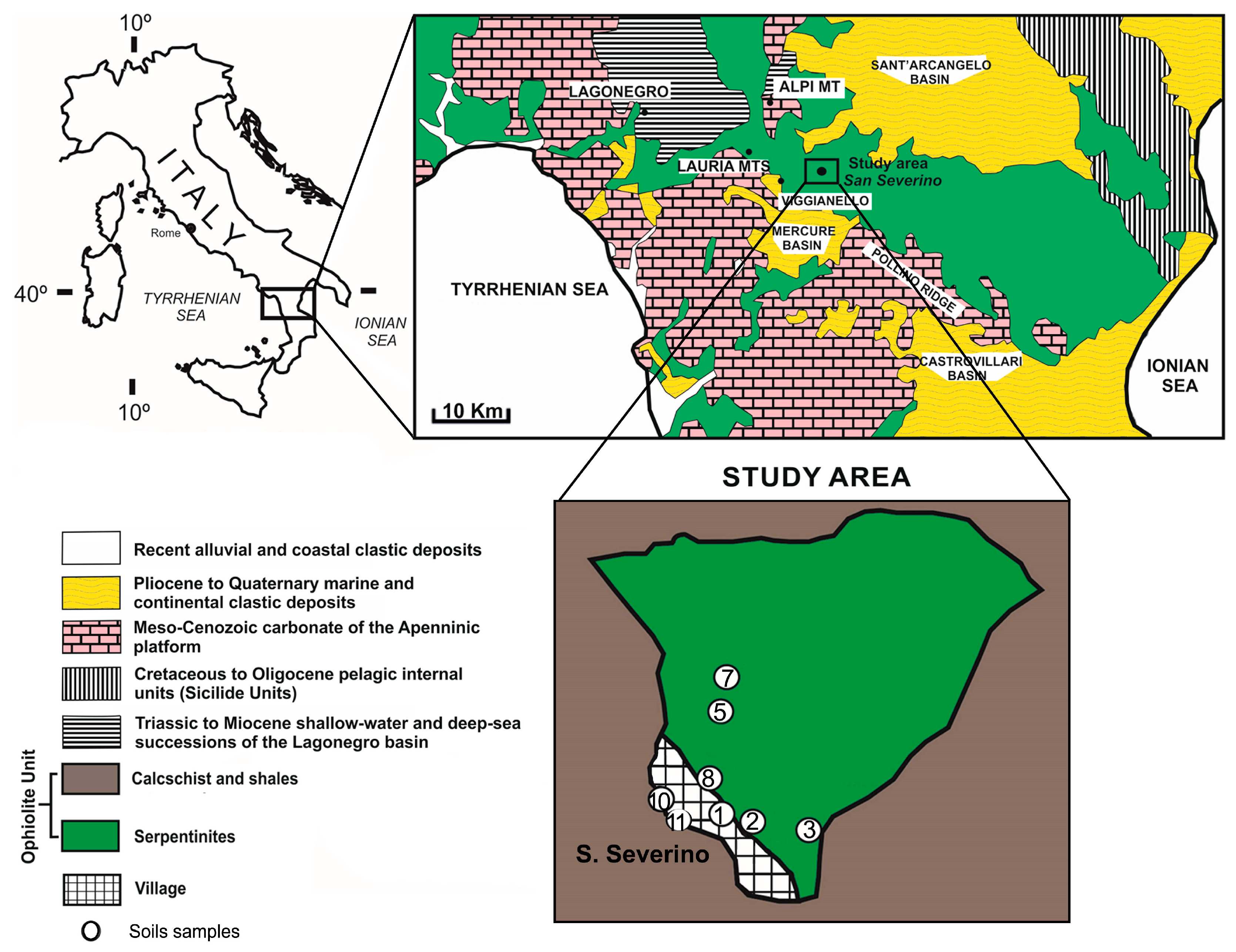

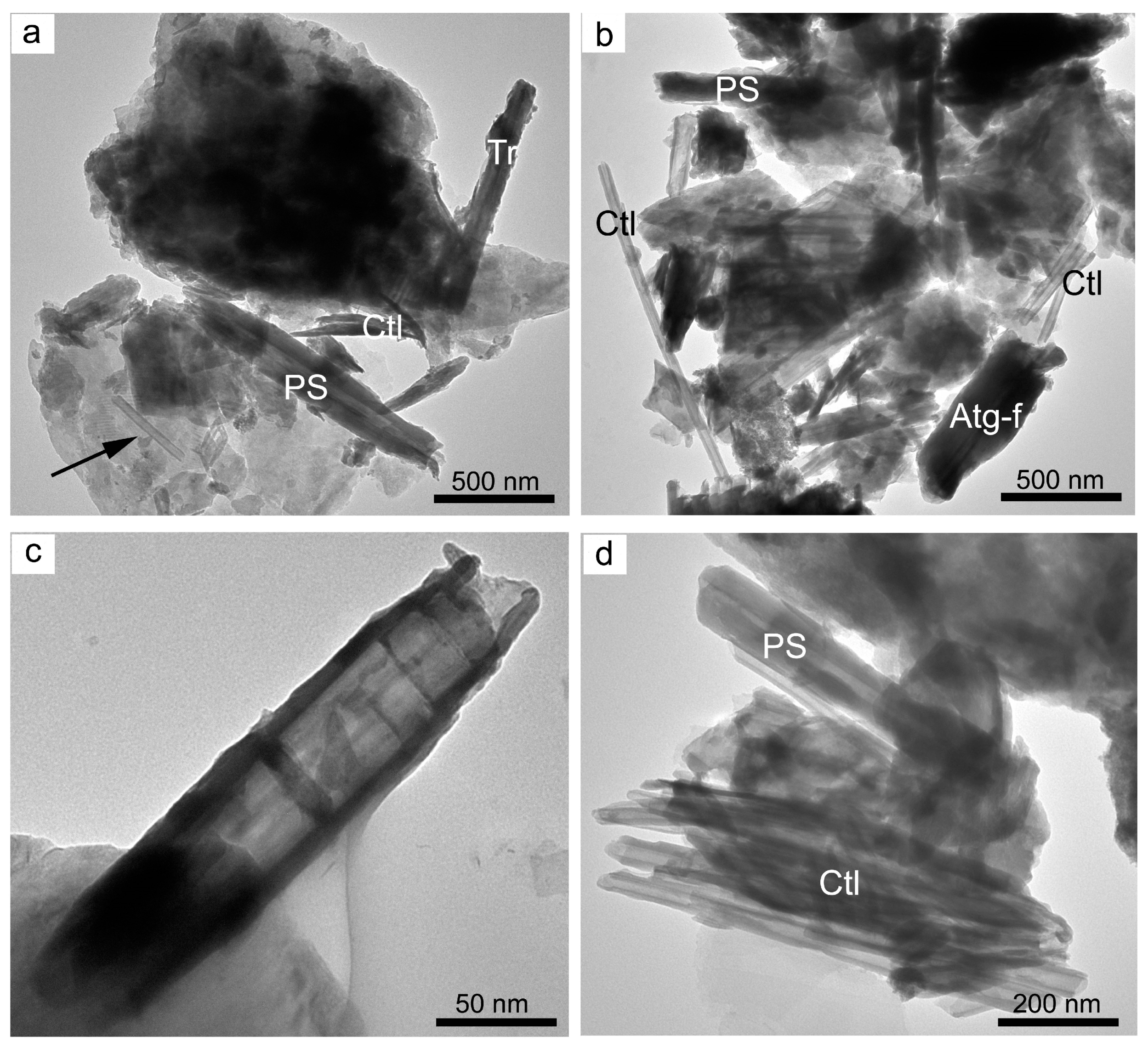
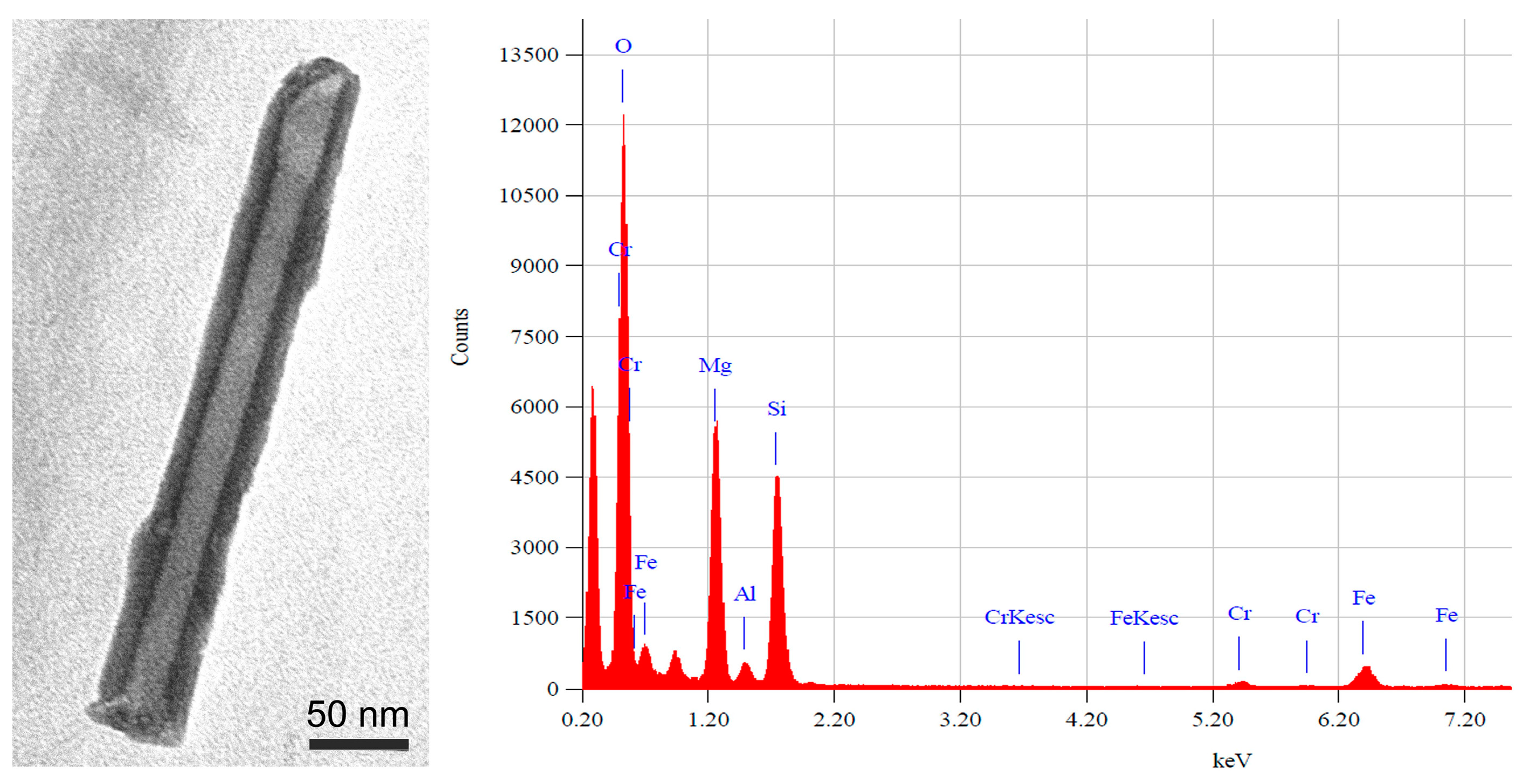
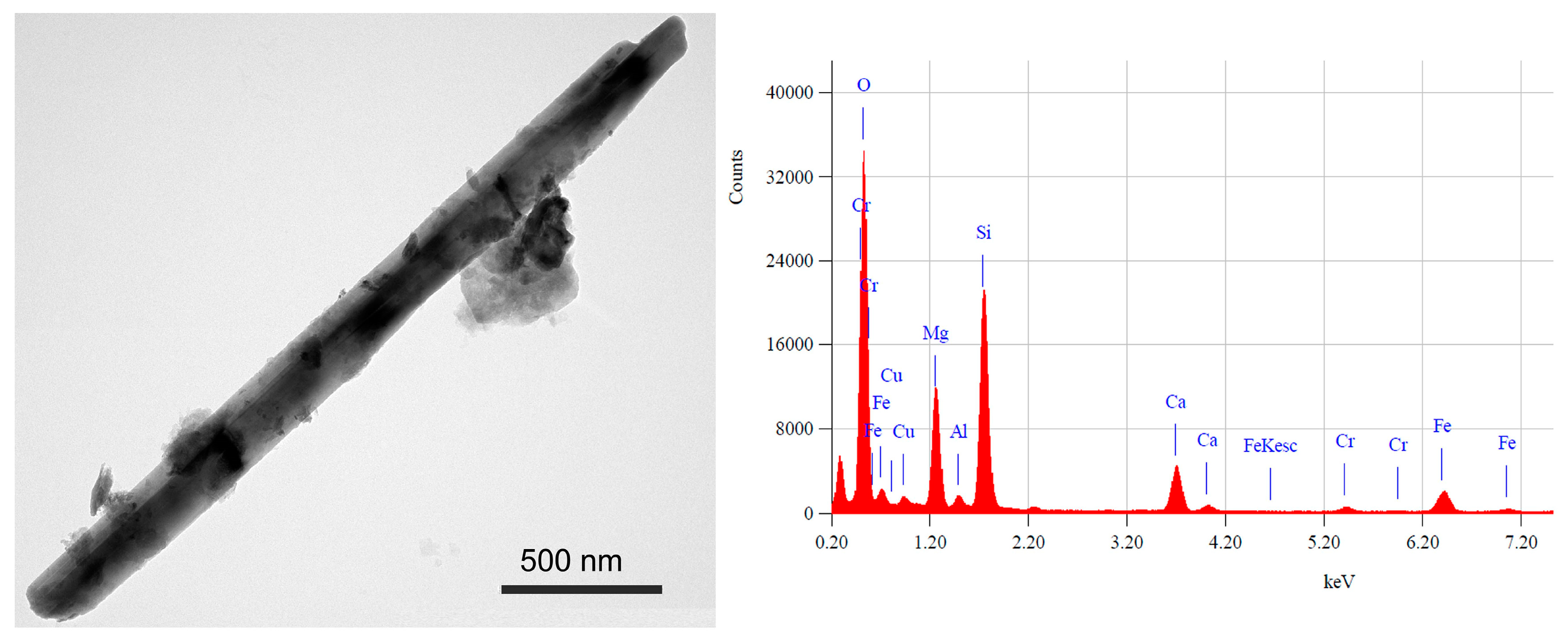
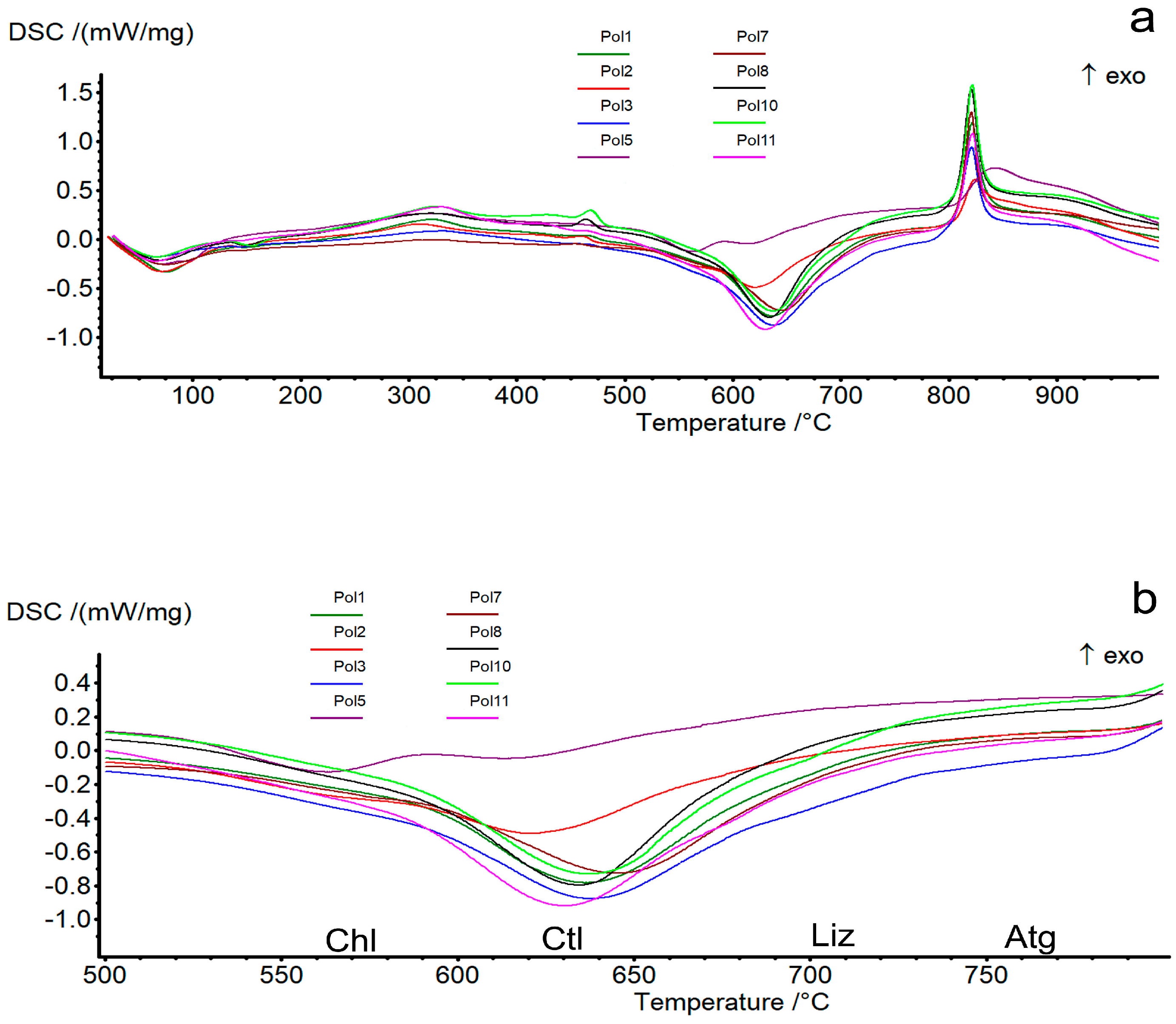

| Sample | Site Description | Longitude (East) | Latitude (North) | Phases Detected |
|---|---|---|---|---|
| Spol1 | At the entrance of the Village | 597,417 | 4,429,775 | Ctl, PS, Ant, Tr (Di, Qtz, Mnt-Chl) * |
| Spol2 | At the entrance of the Village | 597,405 | 4,430,523 | Ctl, f-Ant (Di, Qtz, Mnt-Chl, Tr) * |
| Spol3 | Road cut outside the Village | 597,808 | 4,430,474 | Ctl, PS, Liz, f-Ant (Di, Qtz, Mnt-Chl, Tr) * |
| Spol5 | Road cut outside the Village | 597,270 | 4,431,103 | Ctl, Liz, Ant (Di, Qtz, Mnt-Chl, Tr, Chm, Ms) * |
| Spol7 | Road cut outside the Village | 597,323 | 4,431,363 | Ctl, Tr, (Di, Qtz, Mnt-Chl, Chm) * |
| Spol8 | Road cut within the Village | 597,223 | 4,430,711 | Ctl, PS, Ant (Di, Qtz, Mnt-Chl, Tr, Chm) * |
| Spol10 | Road cut within the Village | 596,890 | 4,430,715 | Ctl, PS, Ant (Di, Qtz, Mnt-Chl, Tr, Chm, Mo) * |
| Spol11 | Road cut within the Village | 596,890 | 4,430,715 | Ctl, PS (Di, Qtz, Mnt, Tr, Chm) * |
| Samples | Spol1 | Spol2 | Spol3 | Spol5 | Spol7 | Spol8 | Spol10 | Spol11 |
|---|---|---|---|---|---|---|---|---|
| DSC | ||||||||
| Chl | 563 en(w) | |||||||
| Ctl | 636 en(s) | 621 en(s) | 638 en(s) | 612 en(w) | 645 en(w) | 634 en(s) | 637 en(s) | 630 en(s) |
| Fo | 822 ex(ss) | 824 ex(ss) | 821 ex(ss) | 844 ex(s) | 821 ex(ss) | 821 ex(ss) | 822 ex(ss) | 822 ex(ss) |
| DTG | ||||||||
| Chl | 564 en(vw) | 563 en(w) | ||||||
| Ctl | 637 en(ss) | 619 en(s) | 638 en(s) | 614 en(w) | 647 en(ss) | 634 en(s) | 639 en(ss) | 631 en(ss) |
| PS | 679 en(vw) | 686 en(vw) | 677 en(vw) | 688 en(vw) | 679 en(vw) | |||
| Liz | 736 en(sh) | 744 en(sh) | ||||||
| Ant | 774 en(sh) | 784 en(vw) | 784 en(sh) | 790 en(w) | 778 en(sh) | 770 en(sh) | ||
| Spol1 | Spol2 | ||
| T range (°C) | TG loss % | T range (°C) | TG loss % |
| <110 | 3.57 | <110 | 3.30 |
| TOT loss at 1000 | 17.44 | TOT loss at 1000 | 14.80 |
| Spol3 | Spol5 | ||
| T range (°C) | TG loss % | T range (°C) | TG loss % |
| <110 | 1.47 | <110 | 3.94 |
| TOT loss at 1000 | 13.13 | TOT loss at 1000 | 12.08 |
| Spol7 | Spol8 | ||
| T range (°C) | TG loss % | T range (°C) | TG loss % |
| <110 | 2.16 | <110 | 2.39 |
| TOT loss at 1000 | 12.24 | TOT loss at 1000 | 14.90 |
| Spol10 | Spol11 | ||
| T range (°C) | TG loss % | T range (°C) | TG loss % |
| <110 | 1.96 | <110 | 2.78 |
| TOT loss at 1000 | 15.40 | TOT loss at 1000 | 15.42 |
© 2019 by the authors. Licensee MDPI, Basel, Switzerland. This article is an open access article distributed under the terms and conditions of the Creative Commons Attribution (CC BY) license (http://creativecommons.org/licenses/by/4.0/).
Share and Cite
Punturo, R.; Ricchiuti, C.; Bloise, A. Assessment of Serpentine Group Minerals in Soils: A Case Study from the Village of San Severino Lucano (Basilicata, Southern Italy). Fibers 2019, 7, 18. https://doi.org/10.3390/fib7020018
Punturo R, Ricchiuti C, Bloise A. Assessment of Serpentine Group Minerals in Soils: A Case Study from the Village of San Severino Lucano (Basilicata, Southern Italy). Fibers. 2019; 7(2):18. https://doi.org/10.3390/fib7020018
Chicago/Turabian StylePunturo, Rosalda, Claudia Ricchiuti, and Andrea Bloise. 2019. "Assessment of Serpentine Group Minerals in Soils: A Case Study from the Village of San Severino Lucano (Basilicata, Southern Italy)" Fibers 7, no. 2: 18. https://doi.org/10.3390/fib7020018
APA StylePunturo, R., Ricchiuti, C., & Bloise, A. (2019). Assessment of Serpentine Group Minerals in Soils: A Case Study from the Village of San Severino Lucano (Basilicata, Southern Italy). Fibers, 7(2), 18. https://doi.org/10.3390/fib7020018






